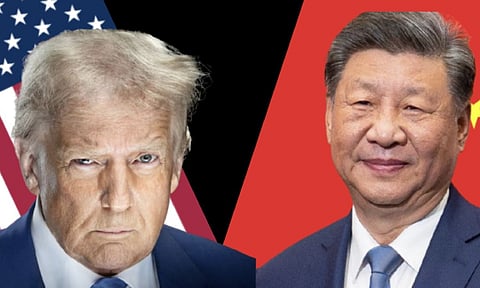

NEW YORK: Once upon a time, many Americans believed China would inevitably become more like us just by plugging into the world trading order that we established and maybe, as President Bill Clinton once suggested, even democratise. The final victory of American-led neoliberalism was close at hand.
Clinton and others like him weren’t entirely wrong. China has spent decades emulating key elements of the American model of entrepreneurialism, consumerism and integration with global markets. It made China an industrial power, with a large middle class, cutting-edge science and technology, and global brands like Huawei, Lenovo and Alibaba. China’s 1.4 billion people live far more diverse and prosperous lifestyles than ever. Through it all, America was the model.
What neither Americans nor Chinese imagined was how much this would become a two-way street.
In the great contest of ideas and influence between the two countries, the pendulum seems as if it’s swinging back the other way. Donald Trump’s return to office has made clear that in important respects — democratic erosion, the fixation on strong borders, the curbing of free speech and numerous other examples — America is starting to look a bit more like China.
I’ve lived in Shanghai since 2008, with a front-row seat to the culmination of China’s rise. There is indeed much that America can learn from China. But perhaps the most important lesson is to stay true to who we are as a nation. That’s what China did. It adopted aspects of the American way that would make it strong again, while sticking to its core system of Communist Party political domination and heavy state involvement in everything. And it has been spectacularly successful.
Trump’s America, on the other hand, is beginning to seem as if it’s taking cues from China’s political model. That’s not who we are.
The MAGA movement and its leaders demonise the Chinese Communist Party. But some of their actions validate the party’s ways, showing that practically speaking, they seem to want similar things.
Both push a muscular patriotism, are obsessed with manufacturing and hostile to immigrants. Both want a country where ethnic minorities are expected to bow to the dominant group and traditional gender roles are enforced. And all of this is presided over by a domineering ruling party led by an autocrat who flatters himself with military parades. Imitation is indeed the highest form of flattery.
The evidence mounts daily.
China weaponises its economy to punish trading partners over various disputes or mere slights; the Trump administration squeezes US allies with arbitrary tariffs or other retaliation over issues such as fentanyl and politics.
Geopolitically, China prioritises relationships of convenience, such as its ties with Russia, over formal alliances. It bullies its neighbours, stoking territorial disputes with a mentality summed up by former Foreign Minister Yang Jiechi, who bluntly told Southeast Asian officials in 2010 that “China is a big country and other countries are small countries, and that’s just a fact.” Trump, too, sees little value in alliances and seems intent on alienating friends and neighbours with his threats to absorb Canada and Greenland and moving to rename the Gulf of Mexico.
Economically, Americans have long criticised China for overemphasising manufacturing and flooding world markets with Chinese goods while neglecting to spur domestic consumption that would balance its economy and trade. But much like Xi, MAGA leaders see manufacturing as noble and globalisation as turning Americans into passive consumers.
As different as the US and China are, deeply similar national conditions are driving this convergence.
China leaned into the American model to rebuild industrially and catch up to the West. Today, it is America that is worried about falling behind. People in both countries worry about artificial intelligence and automation taking jobs and changing how we work, live and interact as a society. Many disillusioned young people in both countries feel left out of their nation’s economies and wonder what’s the point of pursuing careers.
These shared challenges, not surprisingly, lead to similarly populist political solutions. For Xi, it’s the Chinese Dream, his patriotic vision of a China restored to its ancient prosperity and power. Trump has ridden its younger sibling, “Make America Great Again,” to two election victories.
Much of what China does is worthy of respect. Its government makes farsighted industrial policy as a matter of habit. It proactively presents new technologies like artificial intelligence to its people as positive forces, introducing them in ways that benefit the public, such as in education and health care. China is aggressively transitioning to renewable energy, and new estimates indicate that its greenhouse gas emissions have begun to fall for the first time. China has clean, safe, efficient and high-tech cities, knit together by immaculate highways and a state-of-the-art rail network. Government funding and investment are flowing into education, science and technology. It’s natural for Americans who want a better future to look, albeit grudgingly, at what China has achieved.
The US can and should consider adopting some of what has worked for China, such as transitioning to renewables; revitalising industrial policy; supporting science, research and education; reinvesting in infrastructure, housing and safe cities; and above all, having a sense of collective purpose that leads to national strength. Instead, Trump’s administration is undermining or slashing funding for critical things such as public safety, infrastructure, education, scientific research, clean energy and semiconductor manufacturing, while fanning political divisions.
We can learn from China, but we must find a way to make it work while remaining true to our founding principles. Otherwise, when the smoke clears from the Trump era, America might not be “great again,” but weaker. And we will have found that the student has become the master.
@The New York Times